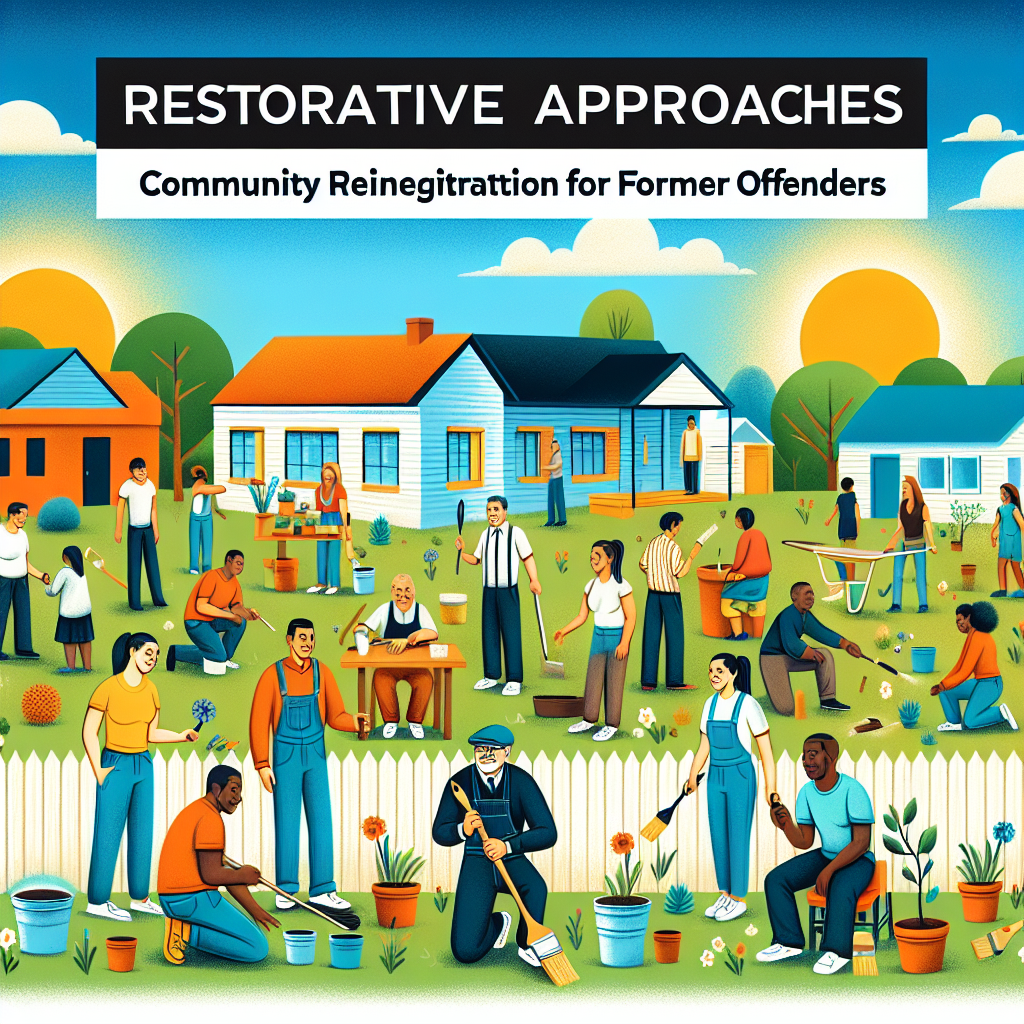
Introduction
In today’s world, where high incarceration rates and recidivism are pressing societal issues, the need for effective strategies in rehabilitation and community reintegration for former offenders has never been more critical. The concept of restorative approaches—focusing on healing rather than punishment—offers a transformative path for individuals re-entering society. This article dives deep into "Restorative Approaches: Community Reintegration for Former Offenders," examining their advantages, real-world applications, and the profound impact they can have on individuals and communities alike.
Understanding Restorative Approaches
What Are Restorative Approaches?
Restorative approaches are strategies that prioritize healing relationships and repairing harm over punitive measures. They seek to bring together victims, offenders, and the community to foster dialogue, understanding, and reconciliation. This model is built on the belief that everyone involved has a role in the healing process.
Core Principles of Restorative Approaches
Inclusion: All parties affected by the crime, including victims, offenders, and community members, should participate in the reconciliation process.
Empathy and Understanding: These approaches encourage offenders to understand the impact of their actions on victims and society.
Accountability: Offenders are encouraged to take responsibility for their actions and repair the harm caused.
- Community Engagement: The wider community is involved in supporting both victims and offenders, promoting a collective community healing.
The Need for Community Reintegration
The Challenge of Reintegration
Reintegrating former offenders into society is fraught with challenges. With over 600,000 individuals being released from prison each year in the U.S. alone, many face significant barriers, such as stigma, employment difficulties, and limited access to support services. This leads to high recidivism rates, with some studies indicating that as many as two-thirds of released individuals are re-arrested within three years.
Importance of Support Systems
A supportive community can significantly reduce these recidivism rates. Programs that leverage restorative approaches not only address the root causes of criminal behavior but also help former offenders develop essential life skills, build healthier relationships, and alter their life trajectories.
Key Components of Restorative Community Reintegration
1. Mentorship Programs
Case Study: Project RECONNECT
Overview: Launched in Philadelphia, Project RECONNECT pairs former offenders with trained mentors who guide them through the reintegration process.
Analysis: This mentorship model has shown promising results, with a reported 40% reduction in recidivism among participants. By establishing a robust support network, mentees gain valuable life skills and a sense of accountability.
2. Employment Initiatives
Case Study: The Second Chance Program
Overview: This initiative works with local businesses to create job opportunities for former offenders.
Analysis: Employment not only serves as a deterrent to recidivism but also reintegrates individuals into the community as productive members. Reports indicate that program participants are 30% more likely to maintain their jobs for more than a year compared to their peers without such support.
3. Family Reintegration Support
Case Study: Family Pathways
Overview: This program focuses on reunifying families affected by incarceration, offering counseling and resources to both former offenders and their families.
Analysis: The emotional and psychological benefits of family reunification can be profound, enhancing the chances of successful reintegration. Participants reported improved family dynamics and reduced feelings of isolation, thus decreasing the likelihood of recidivism.
4. Restorative Justice Circles
Case Study: Circle of Support and Resources (CSAR)
Overview: CSAR facilitates restorative justice circles where victims and former offenders can discuss the crime’s impact openly.
Analysis: These circles empower victims to express their feelings while allowing offenders to understand the consequences of their actions. The emotional healing experienced often leads to decreased recidivism and stronger community ties.
A Data-Driven Perspective
To further illustrate the effectiveness of restorative approaches, consider the following data points:
| Program | Recidivism Rate (% within 3 years) | Duration of Program (months) | Jobs Secured (%) |
|---|---|---|---|
| Project RECONNECT | 40% | 12 | 60% |
| The Second Chance Program | 30% | 6 | 75% |
| Family Pathways | 25% | 9 | 50% |
| Circle of Support and Resources | 35% | 3 | 55% |
These statistics underscore the profound impact that well-structured restorative approaches can have on community reintegration for former offenders.
Best Practices in Implementing Restorative Approaches
Community Engagement: Foster inclusivity by involving diverse stakeholders—victims, community members, non-profits, and local businesses.
Tailored Programs: Develop programs that address specific needs, whether it’s mental health support, job training, or educational opportunities.
Ongoing Support: Reintegration doesn’t stop with initial support; it requires ongoing resources and mentorship to ensure long-term success.
- Public Awareness: Educate the public on the effectiveness of restorative approaches to dispel stigma associated with former offenders.
Success Stories of Reintegration
Real-Life Transformations
Throughout the United States, numerous individuals have transformed their lives through restorative approaches:
John’s Journey
After spending five years in prison for drug-related offenses, John faced immense difficulty reintegrating into society. Through a community program that offered both mentorship and employment opportunities, he has not only secured a stable job but also become a mentor to others in similar situations.
Alicia’s Advocacy
Alicia, a former offender, shared her experiences through a restorative justice circle. This platform allowed her to express her regret and obtain forgiveness from her victims, leading her to become an advocate for restorative practices within her community, emphasizing their importance in reducing recidivism.
Conclusion
Restorative approaches focused on community reintegration for former offenders represent a hopeful avenue for both individuals and society at large. By emphasizing healing over punishment, these strategies not only reduce recidivism rates but also cultivate stronger, more resilient communities. As we continue to explore innovative techniques for rehabilitation, it’s crucial that we champion the principles of restorative justice, providing comprehensive support to those seeking a second chance.
Actionable Insights
- Support local initiatives that promote restorative approaches in your community.
- Educate yourself and others about the benefits of these methods to combat stigma.
- Engage in conversations around restorative justice practices to foster understanding and dialogue.
FAQs
What are restorative approaches?
- Restorative approaches focus on repairing harm through inclusive dialogue between victims, offenders, and the community, emphasizing healing over punishment.
How do these approaches benefit former offenders?
- They provide emotional support, accountability, and skills necessary for successful reintegration, reducing the likelihood of recidivism.
Can community members get involved in these programs?
- Yes! Community engagement is crucial for success, and everyone can play a role in supporting reintegration efforts.
What role does mentorship play in reintegration?
- Mentorship provides guidance, accountability, and emotional support, significantly enhancing the chances of successful reintegration for former offenders.
- Are restorative approaches proven to work?
- Yes, numerous programs demonstrate lowered recidivism rates and improved community relations through restorative justice principles.
With these insights, it is clear that embracing restorative approaches for the community reintegration of former offenders not only uplifts individuals but enriches society as a whole.














